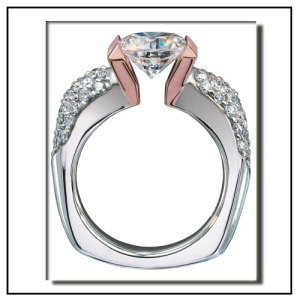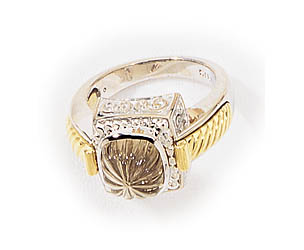 Istanbul is the only city in the world that stretches across two continents. Connecting Europe with Asia, the city straddles more than the Bosphorus River, it straddles cultures. As a child, Sevan Bicakci lived on a street with a church, mosque and temple – three different beliefs that serve as inspiration for the very enigmatic jewelry designer now known simply as Sevan.
Istanbul is the only city in the world that stretches across two continents. Connecting Europe with Asia, the city straddles more than the Bosphorus River, it straddles cultures. As a child, Sevan Bicakci lived on a street with a church, mosque and temple – three different beliefs that serve as inspiration for the very enigmatic jewelry designer now known simply as Sevan.
“Where I am from, rings are the mirrors of the personality of the wearer. They tell all about the wearer,” says the imposing 35-year-old, speaking through an interpreter as he points out favorite pieces in the jewelry case at Stanley Korshak.
His calloused and burned hands seem too huge to finesse the delicate details that are the signature of his three-year-old label, but offer proof of the labor he devotes to each necklace, bracelet and ring.
Sevan began working as a jewelry model-maker at 17 in Istanbul’s Grand Bazaar. He developed a reputation as a skilled goldsmith and problem-solver, but spent most of his time producing commercial versions of work by other Turkish jewelers.
Everything changed six years ago when he set out to make a gift for his wife. “There is one sweetheart in life,” Sevan says. “If she’s going to wear a present from me, it should be a unique one.”
A ring was made – and a manifesto was born.
Inspired by the early 20th-century Arts and Crafts movement, Sevan rebelled against mass production. He began working with his brother and produced 30 rings the first year, throwing away more than he sold. Incorporating non-jewelry techniques, such as stained-glass and mosaic, into his work, Sevan earned a new reputation in the Grand Bazaar, this time inspiring other artisans to join him.
Today he oversees a team of 35 craftsmen, but produces only 400 one-of-a-kind pieces each year. A single ring, his specialty, can take from three months to a year to complete. The more laborious pieces involve micro-mosaic, a Sevan signature that may incorporate up to 12,000 pieces of ceramic tile or porcelain.
 Reverse hand-carvings are another signature. Sevan personally carves each stone from underneath, depicting remarkably detailed, three-dimensional sculptures of whirling dervishes, the Virgin Mary, or even ladybugs.
Reverse hand-carvings are another signature. Sevan personally carves each stone from underneath, depicting remarkably detailed, three-dimensional sculptures of whirling dervishes, the Virgin Mary, or even ladybugs.
The loss percentage is high, with eight to 10 stones ruined for each success. The gem’s interior is then painted and filled with clear enamel, before being set on an elaborately intricate band.
Sevan says the environment of Istanbul and its history propel his work. “I enjoy dreaming of myself as an Ottoman sultan, and sometimes I become his concubine or a Byzantine queen. The question then becomes, what would they wear if they lived now?”
Latter-day Byzantine queens Halle Berry, Tory Burch, Mary-Kate Olsen, Brooke Shields and Celine Dion are among those who wear his designs. And, he affirms, they pay retail. (Translation: from about $7,000 for a gold and sterling bracelet, to $58,000 for a ring with an Istanbul mosque carved into lemon topaz.)
“The Ottoman Renaissance never happened,” Sevan acknowledges, “but I like to think it is now.
“The ideas are new, but the techniques are old.”
World’s most prestigious jewelry award goes to Sevan Bicakci
Stating that competition between jewelry brands in the US market is very tough, Bicakci said that he produces only one piece of jewelry for each model range and this uniqueness allowed him to sell his work at places such as Hollywood Barneys as well as New York, Chicago and the Las Vegas Barneys. Bicakci also has a number of collectors across the world.
 Istanbul-based jewelry designer Sevan Bicakci was chosen as the winner of the prestigious “Town & Country Couture” Design award, considered to be the Oscar of the jewelry world. He was given the award in a ceremony held in Las Vegas in Spring 2006.
Istanbul-based jewelry designer Sevan Bicakci was chosen as the winner of the prestigious “Town & Country Couture” Design award, considered to be the Oscar of the jewelry world. He was given the award in a ceremony held in Las Vegas in Spring 2006.
Bicakci also received the Tanzania-based Tanzanite Foundation’s Celebration of Life Jewelry Design award for a ring in his ‘Door Collection’ in the Independent Designer category of the competition held in the United States this year, leaving world-renowned jewelry brands behind. The style of his award winning design is regarded as an invention in the jewelry world.
Bicakci said he participated in the competition at the invitation of the Tanzanite Foundation but he couldn’t even imagine how to take part in the competition due to the astronomical price of the ring’s stone. The rare and precious tanzanite stone in parliament blue was thus provided by the foundation.
Stating that competition between jewelry brands in the U.S market is very tough, Bicakci said that he produces only one piece of jewelry for each model range and this uniqueness allowed him to sell his work at places such as Hollywood Barneys as well as New York, Chicago and the Las Vegas Barneys. Bicakci also has a number of collectors across the world.
He said the awards and competitions weren’t so important for him, however, he highlighted the importance of taking part in such events in order to be recognized in the U.S.-dominated jewelry industry.
His work is comprised of portraits, statues, glass collections and his latest collection is called Bug and Sea Products. He that he has some ambitious projects and has worked for months on the designs, adding, My new works will turn the signature of Sevan Bicakci from the temperament of jelly to bone.



















 Fashion rings are by far the most exciting jewelry item. They have that unique ability and function to express our ever-changing mood. With few limits and boundaries, fashion rings can be set with a variety of stones including aquamarine, topaz, moonstone, onyx, tiger's eye, and more. However, it is the presentation and overall design of a ring that signifies it as a fashion ring. Typically, the more wild the design, the more likely it is to be a great fashion ring.
Fashion rings are by far the most exciting jewelry item. They have that unique ability and function to express our ever-changing mood. With few limits and boundaries, fashion rings can be set with a variety of stones including aquamarine, topaz, moonstone, onyx, tiger's eye, and more. However, it is the presentation and overall design of a ring that signifies it as a fashion ring. Typically, the more wild the design, the more likely it is to be a great fashion ring. The
The
 The Dubai International Jewellery Week, the new format of the country’s largest such exhibition, opened Tuesday. Some 300 exhibitors are showcasing their goods to a crowd consisting of wholesalers, retailers and many consumers.
The Dubai International Jewellery Week, the new format of the country’s largest such exhibition, opened Tuesday. Some 300 exhibitors are showcasing their goods to a crowd consisting of wholesalers, retailers and many consumers. Istanbul is the only city in the world that stretches across two continents. Connecting Europe with Asia, the city straddles more than the Bosphorus River, it straddles cultures. As a child, Sevan Bicakci lived on a street with a church, mosque and temple – three different beliefs that serve as inspiration for the very enigmatic jewelry designer now known simply as Sevan.
Istanbul is the only city in the world that stretches across two continents. Connecting Europe with Asia, the city straddles more than the Bosphorus River, it straddles cultures. As a child, Sevan Bicakci lived on a street with a church, mosque and temple – three different beliefs that serve as inspiration for the very enigmatic jewelry designer now known simply as Sevan. Reverse hand-carvings are another signature. Sevan personally carves each stone from underneath, depicting remarkably detailed, three-dimensional sculptures of whirling dervishes, the Virgin Mary, or even ladybugs.
Reverse hand-carvings are another signature. Sevan personally carves each stone from underneath, depicting remarkably detailed, three-dimensional sculptures of whirling dervishes, the Virgin Mary, or even ladybugs. Istanbul-based jewelry designer Sevan Bicakci was chosen as the winner of the prestigious “Town & Country Couture” Design award, considered to be the Oscar of the jewelry world. He was given the award in a ceremony held in Las Vegas in Spring 2006.
Istanbul-based jewelry designer Sevan Bicakci was chosen as the winner of the prestigious “Town & Country Couture” Design award, considered to be the Oscar of the jewelry world. He was given the award in a ceremony held in Las Vegas in Spring 2006.


















